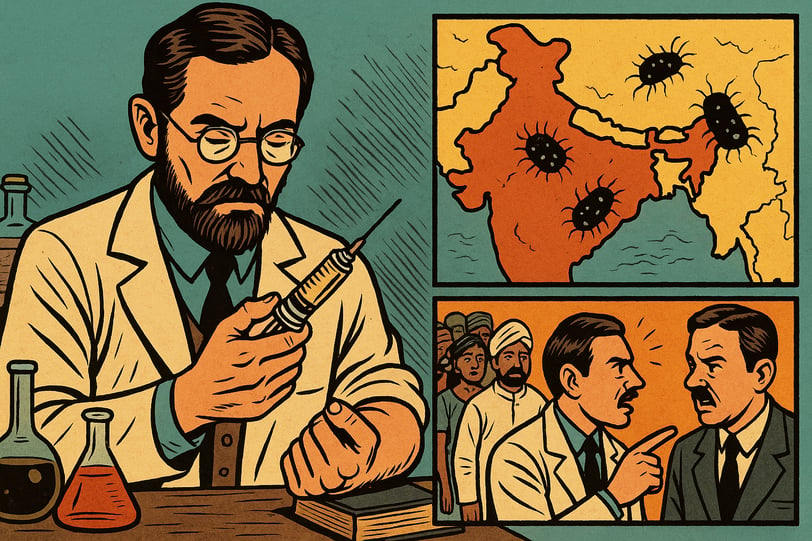The Man Who Injected Himself With the Plague and Lived
In 1897, a scientist injected himself with the bubonic plague to test a vaccine. Discover the shocking true story of the man who lived to tell it.
HISTORICAL WTF
Driver
5/25/20253 min read


🧫 The Man Who Injected Himself With a Deadly Bacteria—And Survived
What would drive someone to inject themselves with one of the world’s most dangerous pathogens?
No, this isn’t the plot of a horror movie. It’s a true story — and not of a madman, but a respected scientist. In 1927, a doctor willingly became a human guinea pig in one of the most bizarre and borderline suicidal experiments in modern medical history.
The microbe? Yersinia pestis.
The disease? The bubonic plague.
Yes — the same plague that wiped out a third of Europe in the 14th century.
Here’s how one man’s risky gamble helped us better understand a disease that once terrorized the planet — and how he somehow lived to tell the tale.
👨🔬 Meet Dr. Waldemar Haffkine: Scientist, Survivor, Human Lab Rat
Born in 1860 in Odessa, then part of the Russian Empire, Waldemar Mordecai Haffkine was a bacteriologist, trained under Louis Pasteur, and already known for developing an early cholera vaccine.
But by the mid-1890s, Haffkine had his sights on an even bigger enemy: the plague.
In 1894, an outbreak of bubonic plague began to sweep through British-ruled India, threatening to devastate millions. The British colonial government, desperate and poorly equipped, turned to Haffkine.
With limited time and resources, he did something few modern scientists would dare to do.
He created a plague vaccine.
Then he injected himself with it first.
💉 The Self-Injection: Desperation or Bravery?
Haffkine wasn’t a reckless man. He knew the risks. The vaccine he developed was experimental, unapproved, and created using heat-killed cultures of Yersinia pestis. He didn’t even test it on animals first — because he didn’t have time.
In January 1897, in a cramped laboratory in Bombay, Haffkine rolled up his sleeve and became Patient Zero in his own trial.
No backup.
No trial group.
No safety net.
A few hours later, he developed fever, chills, and nausea — signs of the vaccine triggering a strong immune response. But within 24 hours, he stabilized.
He had survived.
🏥 Results That Shocked the Empire
After that dramatic beginning, Haffkine began wider testing — first on volunteers, then on entire communities in India, where the plague was ravaging cities and villages.
The results were astonishing:
Mortality rates among vaccinated populations plummeted.
Unvaccinated areas continued to suffer devastating death tolls.
By the early 20th century, millions had been vaccinated thanks to his formula.
He became a hero in India. Villagers called him “The Savior from the West.” Even the British press, often skeptical of science, praised him.
And yet, despite his success… his story nearly ended in disgrace.
🦠 The “Little Bag Incident” That Almost Ruined Him
In 1902, disaster struck. A batch of his vaccine in Punjab was contaminated — and 19 people died.
The press exploded. British officials, uncomfortable with a Jewish-Russian scientist being praised on the world stage, seized the opportunity. Haffkine was blamed, dismissed, and effectively exiled from his own laboratory.
Years later, an investigation cleared him: the deaths had been caused by a local lab assistant’s error, not Haffkine’s formula.
But the damage was done. The scandal haunted him for the rest of his life.
🧬 A Legacy Buried in Dust — And Revival
Despite having saved tens of thousands — if not millions — of lives, Haffkine was largely forgotten outside of India. He retired to France, where he lived quietly, far from the headlines he once commanded.
Only in recent decades has his story been reclaimed by historians and scientists who recognize his unique place in medical history:
The first person to create and administer a plague vaccine
The first to prove it worked — on himself
A rare case of deliberate self-experimentation that actually succeeded
And perhaps most bizarre of all: he never contracted the plague, despite working directly with it for decades.
🧠 Why This Matters Today
In an age where vaccine skepticism runs high and public trust in science often wavers, Haffkine’s story reminds us of a time when scientists risked their lives — literally — to protect others.
His actions may seem extreme, even unthinkable now. But in 1897, with no time for bureaucracy or clinical trials, he chose bravery over comfort. And it worked.
No viral videos. No patents. Just courage, sweat, and a syringe.
And the fact that we even have modern plague vaccines at all? It all began with that one injection… into himself.
📚 Sources / References:
British Medical Journal Archives – The Life and Work of Waldemar Haffkine
The Lancet – Bubonic Plague: The Vaccine That Changed the British Raj
The Guardian – Unsung Heroes of Science: Haffkine, the Forgotten Vaccine Pioneer
India Today – Plague, Politics and Redemption: The Story of Haffkine
World Health Organization – Historical Vaccine Development Timeline
